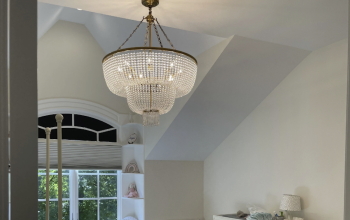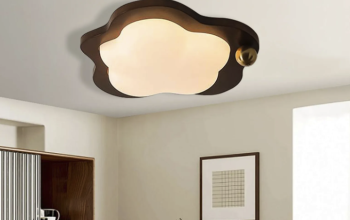Lighting plays a crucial role in home decor as it has the power to make or break the ambiance of a room. The right lighting can transform a dull and lifeless space into a warm and inviting sanctuary. It can also affect our mood and productivity, making it an essential element to consider when designing our homes.
The way a room is lit can greatly impact the overall atmosphere. Soft and warm lighting can create a cozy and intimate feel, perfect for relaxation and unwinding after a long day. On the other hand, bright and vibrant lighting can energize and uplift the mood, making it ideal for areas where productivity is key, such as home offices or study spaces.
Layered Lighting: Creating a Warm and Inviting Atmosphere
One of the key principles in lighting design is layered lighting. This involves using multiple sources of light in a room to create depth and dimension. By incorporating different types of fixtures, you can achieve a well-balanced and visually appealing space.
To achieve layered lighting, it is important to have three main types of lighting: ambient, task, and accent lighting. Ambient lighting provides overall illumination to the room and can be achieved through ceiling fixtures or recessed lights. Task lighting, as the name suggests, is used to illuminate specific task areas such as kitchen countertops or reading nooks. This can be achieved through under-cabinet lights or desk lamps. Lastly, accent lighting is used to highlight architectural features or artwork in the room. This can be achieved through wall sconces or picture lights.
Statement Lighting: Making a Bold Statement with Unique Fixtures
Statement lighting is a great way to add personality and character to a room. It involves using unique fixtures that serve as focal points and make a bold statement. These fixtures not only provide functional lighting but also act as works of art themselves.
There are various types of statement lighting fixtures that can be used to create a wow factor in a room. Chandeliers are a classic choice and can add elegance and grandeur to any space. Pendant lights are another popular option and come in a wide range of styles, from sleek and modern to vintage and industrial. Floor lamps and table lamps with unique designs or interesting materials can also serve as statement pieces.
Task Lighting: Lighting Up Your Work Space and Task Areas
Task lighting is essential in areas where specific tasks are performed, such as the kitchen or home office. It provides focused and concentrated illumination, making it easier to see and work efficiently.
In the kitchen, under-cabinet lights are commonly used to illuminate countertops and provide ample lighting for food preparation. Pendant lights or track lighting can also be used over kitchen islands or dining tables to provide task lighting while adding visual interest.
In the home office, a desk lamp is a must-have for providing direct lighting on the work surface. Adjustable desk lamps with flexible arms or goosenecks are ideal as they allow you to position the light exactly where you need it.
Accent Lighting: Highlighting Your Home’s Best Features
Accent lighting is used to draw attention to specific features or objects in a room. It adds depth and visual interest by creating contrast and highlighting the focal points of the space.
Wall sconces are a popular choice for accent lighting as they can be installed on either side of a fireplace, artwork, or architectural feature to create a dramatic effect. Picture lights are another option for accentuating artwork or photographs on the wall.
Recessed lights with adjustable trims can also be used for accent lighting by directing the light towards a specific area or object. This is particularly effective in highlighting sculptures or decorative elements.
Outdoor Lighting: Enhancing Your Home’s Curb Appeal and Security

Outdoor lighting is not only important for safety but also plays a significant role in enhancing the curb appeal of your home. It creates a welcoming and inviting atmosphere while also providing security and visibility.
Pathway lights are commonly used to illuminate walkways and driveways, making it easier to navigate at night. Wall-mounted lights or lanterns can be used to highlight the entrance of your home and create a warm and inviting ambiance.
Floodlights or spotlights can be used to illuminate specific areas of your outdoor space, such as trees or architectural features. This not only adds visual interest but also enhances the overall aesthetics of your home.
Energy-Efficient Lighting: Saving Money and the Environment
Energy-efficient lighting is not only beneficial for the environment but also helps save money on energy bills. Traditional incandescent bulbs consume a lot of energy and have a short lifespan, whereas energy-efficient options such as LED bulbs are more cost-effective and environmentally friendly.
LED bulbs are known for their longevity and energy efficiency. They use up to 80% less energy than traditional incandescent bulbs and can last up to 25 times longer. They also produce less heat, making them safer to use.
Compact fluorescent lamps (CFLs) are another energy-efficient option that can be used as a replacement for incandescent bulbs. They use about 75% less energy and can last up to 10 times longer.
Smart Lighting: Controlling Your Home’s Lighting with Technology
Smart lighting systems have revolutionized the way we control and interact with our home’s lighting. These systems allow you to control your lights remotely through a smartphone app or voice commands, making it convenient and easy to adjust the lighting according to your preferences.
One of the main benefits of smart lighting is the ability to create customized lighting scenes. You can program different lighting settings for different activities or moods, such as a “movie night” scene with dimmed lights or a “wake-up” scene that gradually increases the brightness in the morning.
Smart lighting systems also offer energy-saving features such as motion sensors or timers that automatically turn off lights when they are not in use. This helps reduce energy consumption and lowers utility bills.
DIY Lighting: Creating Your Own Unique Lighting Fixtures
Creating your own lighting fixtures can be a fun and creative way to add a personal touch to your home decor. It allows you to customize the design and materials according to your preferences, resulting in unique and one-of-a-kind pieces.
There are endless possibilities when it comes to DIY lighting projects. For example, you can repurpose old mason jars or wine bottles into pendant lights by adding a light kit and hanging them from the ceiling. You can also create your own lampshades using fabric, paper, or even natural materials such as twigs or seashells.
If you’re feeling more adventurous, you can try your hand at soldering and create your own custom-designed light fixtures using LED strips or individual LEDs. This allows you to experiment with different shapes and patterns, giving you complete control over the final look of the fixture.
Choosing the Right Lighting for Your Home
In conclusion, lighting is a crucial element in home decor that can greatly impact the ambiance, mood, and functionality of a space. By incorporating layered lighting techniques, statement fixtures, task lighting, accent lighting, outdoor lighting, energy-efficient options, smart systems, and even DIY projects, you can create a well-lit and visually appealing home that reflects your personal style.
When choosing lighting fixtures for your home, it is important to consider the specific needs of each room and the overall design aesthetic you want to achieve. Take into account factors such as the size of the room, the purpose of the space, and the existing decor. Experiment with different types of fixtures and lighting techniques to find what works best for each area.
Remember that lighting is not just about functionality but also about creating a warm and inviting atmosphere. So, don’t be afraid to get creative and have fun with your lighting choices. After all, it’s the little details that make a house feel like a home.




